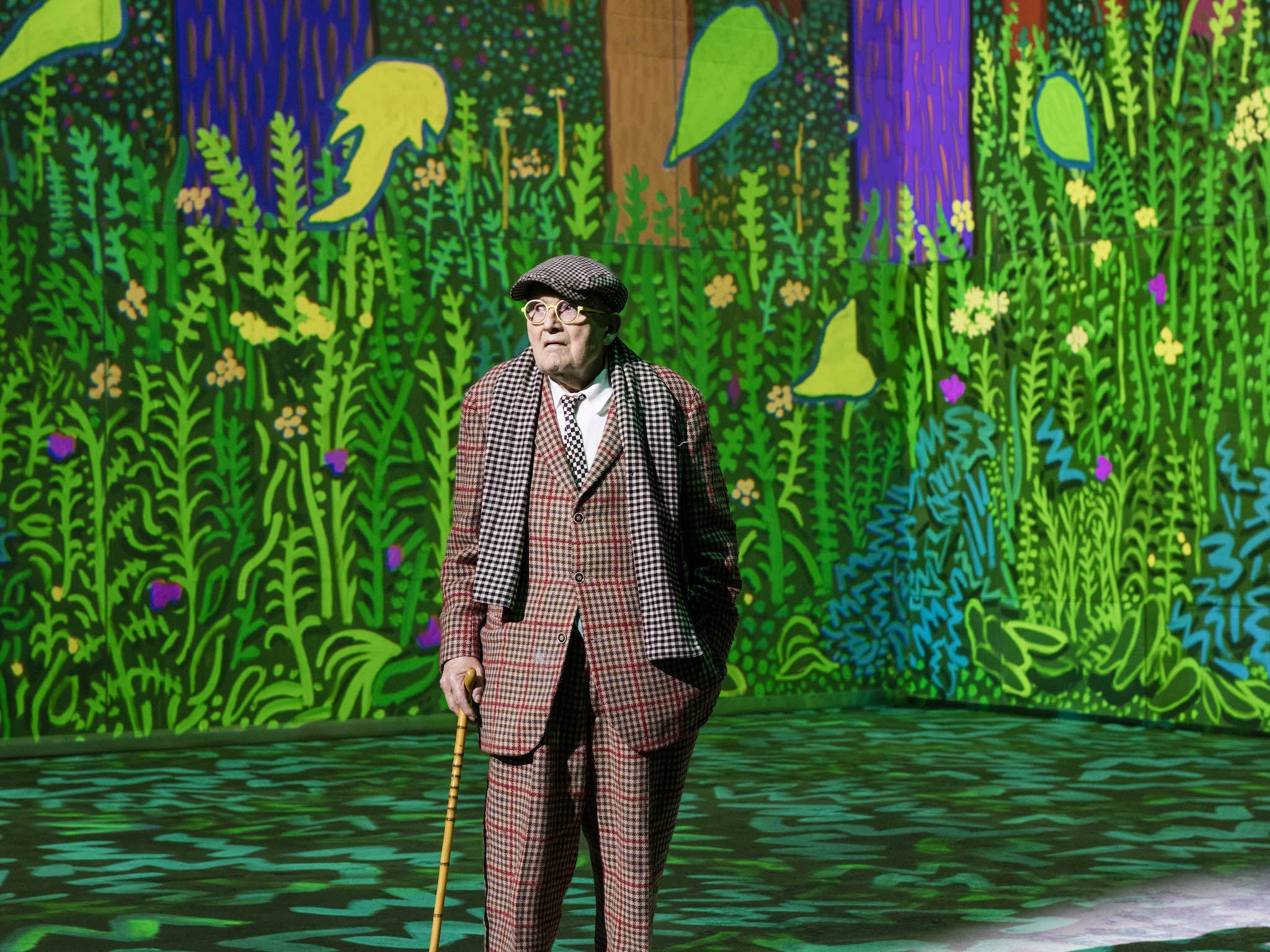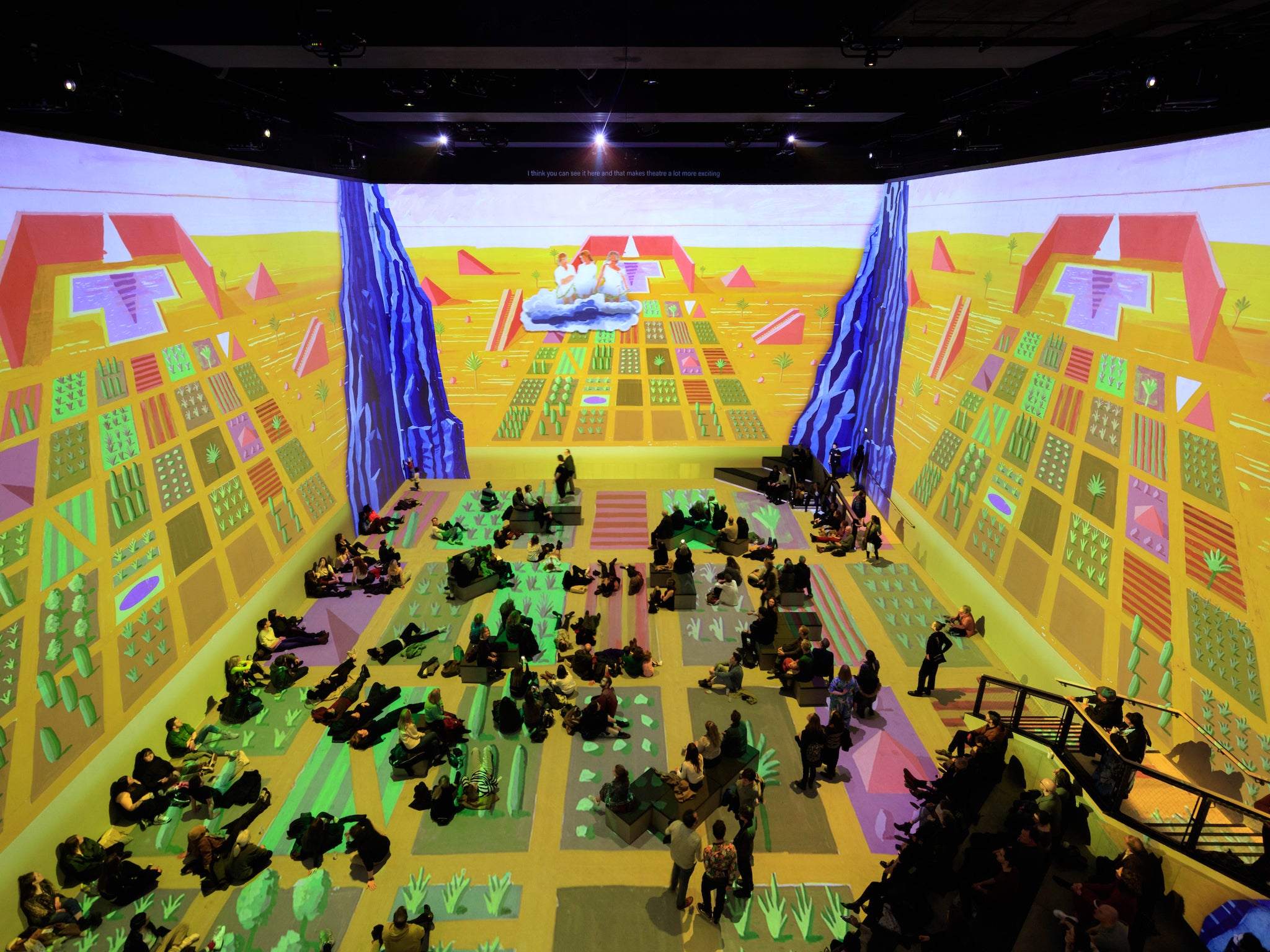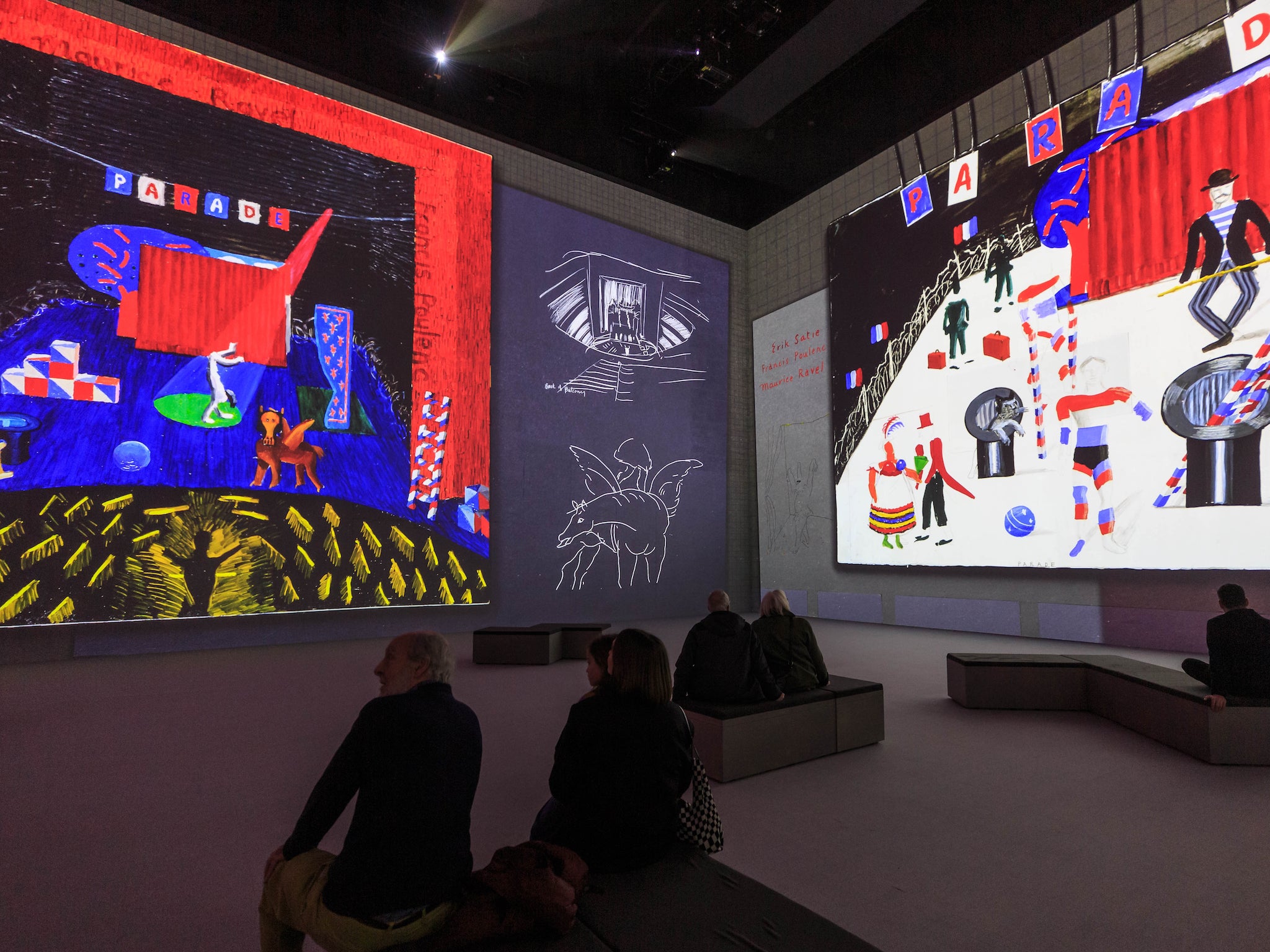David Hockney, Lightroom review: An immersive show that synthesises Hockney’s career in utterly beguiling fashion
The much-loved British artist’s foray into new technology is a breathtaking triumph

Walking along a bleak corridor beneath one of King’s Cross’s newly developed shopping precincts, I’m aware of a blue light ahead, and an elderly and unmistakable northern English voice intoning: “I love life, I’ve always loved life.” It’s the voice, of course, of Britain’s best-loved artist, and as I enter an immense space with a muted green light passing over me and the walls filling, apparently miraculously, with views along Yorkshire lanes, I realise my body’s just been touched by the paintbrush of David Hockney.
The artist whose work’s been turning heads since 1962 has always prided himself on embracing new technologies, from his 1980s multi-perspective photomontages to mid-2000s experiments with iPad drawing. Now he’s taken on a form that feels very much of the moment: the kind of immersive multi-sensory “experience”, generally devoted to a single hugely popular artist, that is very popular with audiences but generally derided by art specialists. The global success of Van Gogh: The Immersive Experience has spawned shows dedicated to Gustav Klimt, Salvador Dali, Frida Kahlo and Diego Rivera, and others.
The difference, though, between David Hockney: Bigger & Closer (not smaller & further away) and, say, the Van Gogh incarnation is that this show has the active involvement of the artist. Indeed, judging from advance statements, Hockney clearly regards it as a work in its own right, and one of his most significant and genuinely innovative to date.
The fact that Bigger & Closer, which marks the opening of Lightroom, a new venue for “spectacular artist-led shows”, is being promoted by companies with experience in theatre – including the team behind the successful Bridge Theatre beside the Thames – feels significant. Hockney has always been a performer: from his arrival on the art scene complete with big glasses and dyed blonde hair, while still a student, to his current belligerence on the subject of smoking. Television, indeed, can be added to the list of technologies Hockney has made his own. The colourful clothes, the droll Yorkshire voice and crystal clarity in explaining his ideas – while still feeling a touch folksy – have all contributed to making Hockney one of the most genuinely popular Englishmen of all time.
I have to admit, though, that I felt intensely sceptical approaching this show, which brings Hockney the performer and Hockney the artist together in a “journey through 60 years of his art”, with the chance to “experience the world through Hockney’s eyes”. Having seen any number of Hockney films and TV documentaries over the years, do I really need to see what will essentially be another one, likely with cheesy music, blown up on a massive scale?
But from the moment I take my seat, with vistas through Hockney World opening out over the vast walls and floor, all apparently drawn by him and changing constantly, with his voice sounding slow and croaky in the middle distance, I’m utterly beguiled. “The world is beautiful,” he gasps, sounding incredibly frail, “when you really look – but most people don’t.” And the frailty is offset in that last phrase by a touch of the combative Yorkshireman, as Nico Muhly’s unashamedly emotive score, wrenches at our heartstrings. Blimey! It’s like meeting Hockney (which I have), being at his memorial service and walking through the Yorkshire of his imagination all at once.
I’m not the greatest fan of Hockney’s Yorkshire paintings, but watching one of his purple-trunked, iPad-painted forests materialising out of the walls, it occurs to me that this is a far better way to see them than on a cold gallery wall. As the walls burst with blossom and the arrival of spring, Hockney is comparing the season to “nature getting an erection” and “champagne sprinkled along the hedgerows”. Even he’s aware that many viewers will have heard these observations before, but the mere fact he’s saying them – again – makes you feel all’s somehow right with the world.
Hockney’s voice moves around in time and space almost as much as the visual imagery
Suddenly the mood changes, and we’re hurtling into one of Hockney’s great preoccupations: the many purposes and varieties of perspective. Florentine single-point perspective opens up on one wall in a view through a church, Chinese aerial perspective on another, and a slightly mystifying Byzantine icon on a third. I’ve barely had the chance to turn and take in the latter before an immensely long Chinese scroll has unfurled around the vast space. Hockney has grown impatient with perspective and is reinventing Cubism in multi-viewpoint photomontages. A portrait of his mother composed of dozens of Polaroids makes a lot more sense here, blown up to the size of a house, than it ever did in a tame little 2ft frame.

There’s a headlong gallop through Hockney’s opera designs, with Hogarth’s engravings plundered for The Rake’s Progress by Stravinsky, and splashes of Chinese colour illuminating Puccini’s Turandot. If we seem to linger slightly too long without Hockney’s voice in an excerpt from Wagner’s Tristan and Isolde, with a static image on a landscape exposing a certain plainness in the original image, the forms have morphed from flatness into uncanny 3D almost before we know what’s happening.
Hockney’s voice moves around in time and space almost as much as the visual imagery: from that octogenarian Yorkshire gasp to a much younger, more bullish and “well-spoken” Hockney from half a century ago.
Flat-grid maps of downtown Los Angeles give way to careering lanes along the nearby San Fernando Valley, uncoiling around the walls in Hockney’s technicolour-painted visions as he talks about his love of the city and the sense of freedom and possibility it gave him as a young man. We join him in the back of a car as he drives us along the valley 40 years ago, with Wagner blasting as it was at the time.

Hockney’s art has always been about sampling from and synthesising different forms and styles, which he splices together with his inimitable graphic wit and flair. It’s an approach that lends itself perfectly to the treatment it’s given here, mutated into a brilliantly transforming vault through Hockney’s art that comes back to the beginning after 55 minutes in which you’ve barely had the chance to catch your breath – though you’re free to watch it as many times as you wish. While much of the credit must go to the filmmakers – notably director Mark Grimmer – the presiding vision and spirit are Hockney’s. One can like some of his works more than others, but there’s no denying the unquenchable energy and enthusiasm that powers his art forward. I’ve fallen in and out of love with Hockney and his work many times over the years, and that I now realise was all part of the journey.
‘David Hockney: Bigger & Closer (not smaller & further away)’ is at Lightroom, King’s Cross, until 4 June



Bookmark popover
Removed from bookmarks